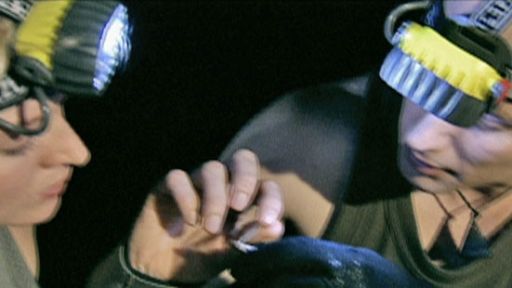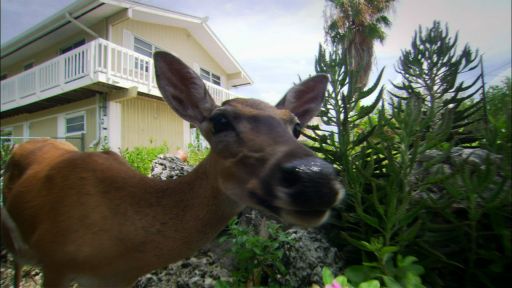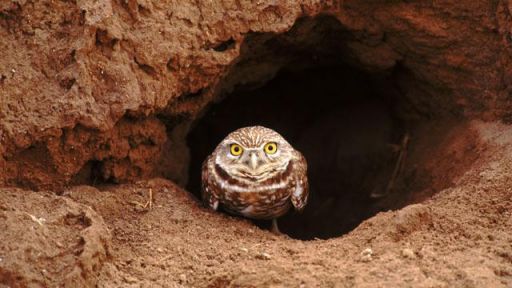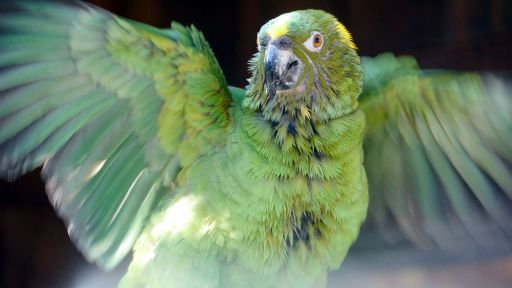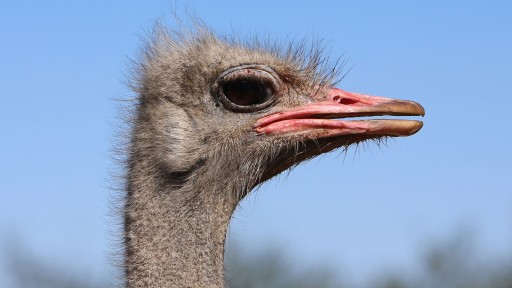TRANSCRIPT
[solemn horn music] - [Jay] Venom.
One man's poison.
- The worst snake bite I've ever seen.
- [Jay] Is another man's cure.
- It's ironic that a toxin from a scorpion is allowing us to treat patients in new and creative ways.
But this is the direction of cancer research in the future.
- [Jay] It's a thin line between life and death.
- There's enough poison in the skin of this frog to kill eight or 10 people.
- [Jay] One that many researchers walk every day.
- She pushed that block away and she bit me on the thumb.
- [Jay] They're searching for a way to transform venom into the elixir of life.
Drawing in a diverse palette of poisonous and exotic creatures, it's a never-ending quest for the venom cure.
[calm synth music] [bright adventurous music] In South Africa, the venomous boomslang spends most of its life in the trees.
That's where it does nearly all of its hunting.
Chameleons mimic a leaf trembling in the wind to keep them concealed from predators and prey.
[insects chirping] It's easy to blow your cover with a boomslang.
They have superb eyesight.
These eyes are the biggest of any African snake.
[soft dramatic music] Once latched on, the snake chews to work its fangs through the chameleon's scaly skin.
Venom runs down grooves on the outside of each fang.
The chameleon's body is flooded with chemicals.
Some of them destroy red blood cells and vessel walls.
Massive internal bleeding soon stops the heart.
Snake venoms have other components that block messages between the nerves and muscles, causing paralysis and death.
The precise composition of venom varies with each species of snake.
The venom helps digest the meal.
After all, it's simply saliva that has become lethal.
But what venom can do to prey, it can do to us.
[snake tail rattling] [intense dramatic music] This is what a rattlesnake bite can do.
[sirens wailing] The venom coursing through his veins is jam-packed with toxic ingredients.
Some of them destroy the flesh around the bite, while others make his muscles twitch violently.
- That's really sick.
It's the worst snake bite I've ever seen.
- [Jay] This man survived the effects of the bite, yet it's just these effects that make venom so interesting.
In northern Florida, George Van Horn is part of the research process.
- [George] Oh, we've got a beauty over here.
- [Jay] Copperhead venom isn't deadly, but it does have some precious properties.
Today it's being used to fight a disease that kills more than 400,000 people every year.
- Just wrapping it up here.
I'm gonna put a knot in the bag.
Ah, this is a lovely southern copperhead.
We'll be taking him back and putting him on the venom line.
- [Jay] There are more than 1000 deadly snakes on the venom line back at Reptile World Serpentarium, including this spectacular albino cobra.
They all produce venom for George, venom which will be sent out to scientists around the world.
One of the biggest orders is for venom from coral snakes, the only members of the cobra family found in North America.
Because they're so small, it's easy to lose your grip.
George uses a plastic tube to help keep control of the deadly head end.
Each coral snake produces only a minuscule amount of venom, so George needs to milk more than 100 to get even enough venom to fill an egg cup.
After being fed, the coral snake is put away.
George has another order to fill.
- [George] Okay.
- [Jay] It's time to introduce the freshly caught copperhead to the production line.
Copperheads are closely related to the rattlesnakes.
Their fangs are long and can strike at an angle.
You need a steady hand for this.
The fangs pierce the membrane just like they would your skin, and venom under pressure in the venom glands oozes out.
Only a few drops, but what powerful drops they are.
This is a miraculous and precious elixir.
The copperhead venom is dried and purified before taking a journey across America.
The University of Southern California, Los Angeles.
Professor Frank Markland is studying a single component of the venom.
Called contortrostatin, it could save the lives of hundreds of thousands of people.
- We're looking at the effect of contortrostatin, which is the name of the protein from a southern copperhead venom, its effect on several different types of cancer.
- [Jay] This snake venom could help treat cancer.
- In the natural environment, this protein probably is used to keep the blood fluid to enable the other more damaging components of the venom to spread rapidly throughout the body and immobilize the prey and that snake can then eat it at its leisure.
In our situation, we want to use this protein in a completely different context.
- [Jay] The new context for contortrostatin is to attack breast cancer cells, protecting healthy cells, and preventing the cancer from spreading.
- We've had very exciting results.
Not only does it inhibit the growth of the primary cancer in the breast by 70 to 80%, it also inhibits spread of the cancer to the lungs.
And so it has a very effective anti-tumor activity in the breast cancer model studies that we've done.
- [Jay] Venom can be helpful in other areas, as well.
A component in the venom of the cottonmouth may not save lives, but it could save your laundry.
This snake's venom could be the ultimate stain remover.
[bright upbeat music] Australia.
Home to the top five most venomous snakes in the world.
The death hatter.
The tiger snake.
The taipan.
The fear snake.
And the brown snake.
It has a venom 12 times more powerful than the deadly Indian cobra, and a reputation to match.
This is Tania Carter.
She has a real affinity with reptiles, from venomous snakes to harmless ant feeders like these.
As a snake catcher, she's often called upon to remove deadly snakes from people's homes.
- Shedding your skin.
- [Jay] Especially one species of snake.
Its venom kills more people than any other on the continent, but it could now turn out to be a lifesaver.
But first Tania has to catch one.
[intense dramatic music] - Eastern brown snake.
Oh, beautiful.
This is an adult, about four and a half feet, but they can grow to between six and seven feet.
They are beautiful snakes, but they are highly venomous.
But as you can see, she's not aggressive.
You find these snakes around things like chicken pens.
And of course, where we have chickens, we have rats and mice and that's what the eastern browns love to eat.
She's just lovely.
Now what we wanna do is gently put her into the bag.
We don't want her to become frightened.
And there she goes.
- [Jay] With the snake in the bag, Tania takes it to close friend and venom collector Neil Charles.
- An eastern brown for you.
- Oh, thanks, Tania.
We should try and get some venom out of it, I think.
- [Jay] Neil harvests venom that's used to make anti-venom to treat snake bite victims.
It's risky work.
- It's a minute amount, but very toxic just the same.
So I think that might be all we're gonna get out of this fellow.
- [Jay] A couple of years ago, Neil was involved in a near fatal accident.
- It was essentially my mistake.
It was a snake that I usually block her into her hide box.
And what had happened is she pushed that block away and she bit me on the thumb.
I applied the constrictive bandage as the first aid.
Immediately went to hospital.
They started taking blood samples from me, applied the appropriate anti-venom, and my recovery was fairly swift.
But when they went back and looked at these blood samples that they'd taken later, they found that there was something really peculiar about what this venom was doing to my blood.
[blood dripping] - [Jay] It was completely shutting down his body's natural de-clotting agents, making his blood clot super fast, and that raised an exciting possibility.
[sirens wailing] Blood loss is one of the worst problems at the scene of an accident.
In extreme cases, you can bleed to death in just four minutes, but paramedics may need much longer to get you to a hospital.
So a spray containing the clotting agent from brown snake venom could be a real lifesaver.
Its blood-staunching power could even be used by surgeons to make procedures like open heart surgery less risky.
This component is just the tip of the venom iceberg.
The race is on to find more venom cures.
Dr. Brian Fry and his wife Alexia have come to Australia's Gulf of Carpentaria to sample venom.
High-powered flashlights and landing nets aren't typical snake-catching gear, but they're not after typical snakes.
- [Alexia] Coming in!
- [Jay] They're here to catch sea snakes.
[Brian talking indistinctly] - [Alexia] Okay?
- Yeah, saw it the other day.
- [Alexia] Look at him go.
- [Brian] A little baby spine belly.
Okay?
- Okay.
Put him away.
- [Jay] The gulf is home to six or seven species, all of them deadly.
- [Brian] Beautiful.
- [Alexia] Okay.
- [Brian] Go in!
That's a big horn.
Okay, three, two, one.
Go.
- Got it?
- Yup.
Yeah, it's a good-sized horn.
- There we go.
Okay, this is called a horned sea snake.
It has two little horns right over the top, like a little medieval dragon.
- The Frys hope to create a database of the venoms from these poorly known snakes.
They have already identified a powerful anticoagulant, which could one day be used to treat potentially fatal coronary conditions.
- [Alexia] Feisty little soul.
- Mmm.
Even though he's just a little baby, there's more than enough venom in there to kill ya.
- [Jay] This is venom with lots of potential, but it isn't easy to collect.
- More.
- There we go.
- Oh my goodness, he's doing well.
- Yeah.
Decent little venom yield.
- Yeah.
- The bigger sea snakes would give you probably about 80 times that amount or enough to fill the, probably fill a thimble.
Here we go.
- Okay.
- Yeah, couple lethal doses.
- All right.
- [Jay] But while new drugs from sea snake venom may be years off, venom from the Gila monster has already shown promise.
This lizard found in the southwestern United States could help treat one of the scourges of modern life: diabetes.
More than 200 million people suffer from this condition, where the body can't control the amount of sugar in the blood.
Barney Tomberlain is a Gila monster expert, and also a diabetic.
He has to inject insulin to control sugar levels in his blood.
Too high or too low, both could be dangerous.
But the Gila monster could help prevent this problem because of its feeding habits.
[brush rustling] These reptiles eat as few as three big meals in a year, but even after a feast like this, they maintain steady levels of blood sugar.
This is made possible by a chemical found in their venom.
[eggs cracking] Heading up 15 years of research focusing on that chemical and how it can help us is a man who has never seen a Gila monster in the wild, Dr. John Eng.
He's meeting up with expert Barney Tomberlain to change all that.
- Gila!
First one I've in the wild.
- What we'd like to do is take some venom from this guy.
You have to have a license to do this.
We'll disturb him, but we'll let him go.
We're gonna fan him a little bit in front and reach in behind and grab him.
- It's a pebbled beady skin, a beautiful pattern.
- [Barney] They have a lot of kind of orange, pink, and black.
- And a very plump tail.
- That's where they keep all their body fat.
Thank you.
We'll take this a piece of hard rubber out.
And if he'll cooperate, we'll try to work that in his mouth.
There he goes.
He's biting it.
And collect the venom this way.
It'll roll out of the bottom glands.
And if we get a pipette out of there, a little capillary tube, should be able to collect a little bit.
Here it is right into the tube.
And he's not the worst for wear, and we can let him go and go on his way.
- [Jay] Venom collection like this provided Dr. Eng with the materials he needed for his research.
- I discovered a component in Gila monster venom that might be useful for treating diabetes.
- Diabetes.
I have diabetes.
How would this be helpful to me?
- This component in Gila monster venom, which I named exendin-4, reduces the blood sugar when it's too high, but becomes much less effective when blood sugar's normal.
- [Jay] And that's crucial.
Now called exenatide, the monster-derived drug is incredibly similar to the natural hormone we produce to help manage blood sugar levels.
The drug stimulate cells to deal with the sugar overload, but unlike injected insulin, it stops working once sugar levels have normalized.
Early results have suggested that this drug may even help diabetics produce their own insulin.
And recent clinical trials show there may be one other added benefit.
The venom component may reduce appetite.
Obesity can be a key factor in the onset of diabetes, so this could really help.
But the Gila monster is just one of many venomous creatures with hidden talents.
A third of the global harvest is lost to pests.
The problem with traditional insecticides is that pests can build up resistance to them.
[upbeat rock music] In Australia, one of the country's most fearsome residents could help.
The beautiful city of Sydney is one of their strongholds.
This man has been called to collect what has become the bane of suburbia, a creature with fangs so formidable They can pierce a lizard's skull.
The Sydney funnel-web spider, considered by some the world's deadliest spider.
Normally it lives out of sight in a silk-topped borough, but building work has driven this spider from her lair.
Fascinating to some, but dangerous all the same.
Fortunately for this little girl, spider expert Harry Wilson is on hand.
- Ah, excellent.
See, this is a female Sydney funnel-web.
You can tell she's a female, a much larger abdomen.
The fangs are pretty much the same size, but her venom is much less poisonous.
They're about six times less poisonous than the males, and they don't have the same component in the venom that kills people, so she wouldn't kill you if she bit you like this, but she would give you a nasty bite.
So I'll just get her into the jar.
There.
- [Jay] Harry collects spiders for Sydney's University of Technology.
He takes them to the lab of a friend, Graham Nicholson, who is a big funnel-web fan.
- Another couple for ya.
- Oh, great.
Fantastic.
That's, that's really good.
Yeah, that's excellent.
Fantastic.
- Yeah.
Okay.
I'll just put them down in the room.
- [Jay] Graham and his team keep more than 400 funnel-webs here for venom research.
It may seem like a lot, but spiders yield only a tiny amount of venom, and milking them is difficult.
The secret is to make them angry, but that's easy.
Apparently, just a whiff of human breath drives them crazy.
- We just simply aggravate the spider usually just by touching it on the legs or simply blowing onto the spider that it rears up.
The fangs are then exposed and the spider will actually start to produce venom at the tips.
We can then remove that venom.
We usually get a couple of drops per spider per milking.
A teaspoon amount of venom can require up to 600 milkings.
- [Jay] So what is this venom for?
Watch the silken layer of a funnel-web for long enough, and you'll see.
This cockroach is about to encounter a venom cocktail designed to incapacitate its prey, specifically cockroaches like this one.
[venom whooshing] Once the venom molecules enter its body, they head straight for the nervous system and paralyze it.
But many other venom molecules don't seem to do anything.
They are designed to target other prey like grasshoppers, beetles, even mice.
They aren't needed to disable a cockroach.
This precision and the fact that nothing has ever become immune to the funnel-web's bite is what drives the research in Sydney.
And it's why Graham's lab workers are checking every biologically active part of the venom.
And as each is separated, Graham tests its action.
- We've actually found about 200 components within the venom of the funnel spider.
There are a number in there that are very potent, very specific for insects.
I've actually already done one of the cockroaches here with one of the compounds.
And I'm just about to do another compound with a different action.
We inject a very small amount of the material, so you can barely see it on the end of the needle.
One causes a paralysis, where the cockroach spasms and eventually dies, and the other compound causes paralysis, so the insect goes into the state where the muscles can't contract, and basically it dies on its back.
We are hoping that these venoms are able to produce some novel compounds.
It's interesting to think that the Sydney funnel-web could be a treasure trove of insecticidal compounds.
- [Jay] So in 10 years or so, we may all owe the Sydney funnel-web spider a debt of gratitude, as global harvests are saved by the use of new pesticides.
But it's in medicine that venoms may prove most productive.
Chronic pain.
It's been described as the modern plague.
More than 70% of us will suffer from it at some time in our lives.
Morphine is often the last resort, but it doesn't always work, and it has serious side effects.
An alternative may come from a surprising source.
Cone shells have been collected for their looks for centuries.
There are more than 600 different species of these marine snails.
The rarest worth thousands of dollars is called the Glory of the Sea.
But now cones are in demand for what's inside their shell.
Australia's Great Barrier Reef is the place to find Malcolm Ford.
Malcolm has harvested marine snails for 40 years.
For most of that time, he collected for the trade in these beautiful shells, some of which are not dangerous at all.
- Here we are.
You don't need gloves for these fellows.
One of the little carries, the gold ringer.
Very, very pretty shell.
- [Jay] The snail's mantle can envelop the whole shell, and actually secretes new layers of shell that enable the cowrie to grow.
But while he once collected for beauty, he now collects for venom.
[water splashing] - Textile cone.
One of the deadly cones.
He's a beauty, and good condition.
Very, very deadly.
There's enough toxin in there to kill somebody.
You've gotta be very careful with them.
Don't put them in your pocket.
It's the last thing to do.
That'll sting you through your shirt.
And if you're out on the reef somewhere three hours from help, you're dead.
Simple as that.
- [Jay] But if you did get harpooned by a cone shell, you wouldn't feel much pain.
And that's why they're so interesting for painkiller research.
This textile cone specializes in hunting other snails.
The brightly-colored siphon samples water currents for the telltale smell of its prey.
When food is close, it extends its proboscis, a remarkable organ with a loaded harpoon inside, that's ready to be fired.
One shot of venom and another.
Deadly venom molecules called conotoxins paralyze the prey's muscles so it can be sucked from its shell and devoured.
But it's fish-eating cone shells that are most deadly to people.
Their venom has evolved to target vertebrates, creatures like us.
This geographic cone shell possesses a deadly biological weapon: venom jam-packed with debilitating conotoxins, and this fish is about to experience it.
[water gurgling] It's over in a flash.
The snail detects its prey by sampling water through its siphon tube.
The harpoon-tipped proboscis emerges from the animal's mouth.
It can stretch out almost the animal's body length to reach its target and shoot.
A venom delivered by harpoon attacks the nervous system.
[graphics whooshing] The conotoxins race to the nerve cell, shutting down many of the normal processes of life, and that includes the sensation of pain.
[graphics whooshing] Many fish have sharp spines that could injure the snail in a prolonged struggle, so the conotoxins need to be incredibly fast-acting.
The fish probably doesn't feel a thing, and that's what intrigues the pharmaceutical companies.
But how do you harvest this venom?
Researchers at the Institute of Molecular Bioscience at Brisbane have an ingenious technique.
- What we do is place a venom collection tube in front of the cone snail and we tease the cone snail by putting a fish in front of it so the cone snail gets excited.
And hopefully it will fire its harpoon through the fish tail and into the venom collection tube.
- [Jay] Each of the components of this venom will be separated and placed in a database of conotoxins.
Scientists are also dissecting the snails for their venom.
There's that remarkable harpoon.
Conotoxins could be an important tool in managing the pain of endstage cancer.
Yet pain is diverse.
There are so many other forms that even conotoxins may not reach.
Sciatica is a nerve pain which can become a chronic condition.
For Canadian Gino Gasparni, there has been no treatment that can deal with his agony.
- The pain started on my back and that's just like if you got a knife inside your body and just keeping moving like, and never stop moving day and night.
I take every kind of medication, starting with morphine.
Nothing work.
Nothing, nothing, nothing at all.
- [Jay] Help could come from a toxin found in a whole variety of creatures.
These harlequin frogs from Costa Rica carry it in their skins.
It's a poison that one day could bring relief from chronic pain to people like Gino.
Another amphibian that carries this virulent poison is the California newt.
It may look harmless, but this little newt could actually kill us.
One tragic story tells of a newt which took refuge in a camper's coffee pot.
Unnoticed, it was percolated along with the coffee, with disastrous results.
[coffee pouring] The newt's poison made this a deadly brew.
[soft dramatic music] [cup clattering] [pot clattering] [soft dramatic music] What terrifying poison could be so fast-acting and so deadly?
It's a mysterious substance.
In normal circumstances, the newt gives predators a chance to avoid it.
A garter snake.
The newt flashes its orange stomach as a warning.
The poison in its skin is called tetrodotoxin, TTX for short.
It's 10,000 times more deadly than cyanide, and the snake is wise to leave well enough alone.
Creatures with TTX can be found in the sea, too.
In south Australia, Dr. Mark Norman is searching for predators that can actually inject TTX with their bite.
[water splashing] [mysterious synth music] These aren't the animals Mark is after, at least for now.
Striped pajama squid are so new to science that virtually nothing is known about them, apart from the fact that nothing can survive being kept in an aquarium with them.
It's thought they release toxic chemicals into the water.
Perhaps their toxins will be useful to us someday.
This is the killer Mark has been searching for.
It's no bigger than a golf ball, yet thanks to TTX, it's one of the ocean's deadliest animals, armed and dangerous.
A blue-ringed octopus.
These animals are generally docile, but there are plenty of authenticated accounts of people handling them with tragic consequences.
But to find out more about its venom, Mark needs to get this octopus back to his lab in Melbourne.
The best way to see the effects of TTX in action is to get the octopus to feed.
Crabs are its favorite food.
- They can get a crab that's bigger than themselves.
It's quick as it can.
It's gotta try and bite because otherwise the crab with those big claw will just tear it to shreds.
It's gotta try and bite with a little beak like a parrot beak, bite the eye stalk or the joints of the crab, and get that venom in as quick as possible.
What the octopus is trying to do is bite into its eye, pump that venom down the optic nerve into the brain.
[graphics whooshing] - [Jay] The venom travels down the optic nerve and explodes into the brain.
[graphics whooshing] It rushes into the gaps between the nerve cells, blocking all the chemical messages that travel from the nerves to the muscles.
The crab is totally paralyzed.
- It's frozen all the commands, all the messages to all the muscles.
So the crab is probably fully conscious, just totally immobilized.
On a human, they affect all your muscles that allow you to breathe and walk and move and run away, and you become completely paralyzed, but your heart keeps beating and your brain keeps working, and you're lying there fully conscious, just waiting to run out of oxygen in your lungs.
You're the living dead for three minutes and then you're the dead dead.
- [Jay] Some scientists believe that TTX is, in fact, the main ingredient in the zombie powders used by Hades voodoo priests.
[victim screaming] Where would voodoo priests get hold of TTX?
A possible source is a group of bizarre fish found in warm waters worldwide.
They may be the answer for pain treatments, too.
Pufferfish, also known as blowfish, have plenty of TTX.
This porcupine puffer is one of nature's little showstoppers.
Like all puffers, when it's threatened it gulps in water and inflates itself into a spiky balloon.
This smooth pufferfish also inflates when in danger, but it's the hidden store of TTX in its body that is the real hard line of defense.
And that's exactly what pharmaceutical companies are after.
But they don't have to chase puffers in the open ocean.
One kind of puffer is already farmed in China.
The fugu puffer is a traditional, if rather daring delicacy, in Japan.
If the chef fails to remove all the TTX, diners can be killed.
But now the poisonous parts of the fugu are a wanted commodity.
The organs that contain the TTX, the liver and the ovaries, each have enough of the chemical for 600 doses of a new painkilling drug.
This drug, called tectin, is just starting clinical trials in Canada.
A thousand times more powerful than morphine and with no known side effects, it may just be what sciatica sufferer Gino Gasparni has been waiting for.
- Oh, look at that.
The pufferfish.
- [May] Hello, Gino.
- Hi.
- Hi.
So we begin to start this trial with the toxin from the pufferfish to eliminate some of your nerve pain that you've been experiencing.
Okay.
I think this is, you know, a very innovative way of looking and treating different type of nerve pain.
- The blowfish, if it can help me, there's be a miracle going on, you know.
- [Jay] It's too early to tell for sure, but the signs for Gino are already encouraging.
Today, the medical possibilities of natural toxins seem endless, but centuries ago, maybe the de Barde himself knew of their powers.
The toad, ugly and venomous, wears yet a precious jewel in his head.
Shakespeare, as you like it.
Perhaps he was thinking about the toad's venom glands.
After all, weren't toads one of the main ingredients of a witch's potion?
Frogs and toads are slow-moving soft-skinned creatures.
Poison in their skins is often their only defense.
And scientists are finding some remarkable substances there.
Poison dart frogs secrete some of the most deadly poisons found in the natural world, yet a component from the poison of one of these frogs has already been tested as the basis for a new pain drug.
New technology has opened up the possibility of looking at each molecule of these animal's poisons, and venom research has really begun to take off.
[leaves rustling] These amphibians should never be underestimated.
If you don't know what you're doing, they can kill.
- Oh, nice.
This is Phyllobates terribilis, the golden poison frog.
The world's most deadly amphibian.
Gonna need some gloves for this.
- [Jay] It's best to be careful.
Poison could enter Ron's body via any small abrasion on his hands.
- The Indians would rub the tip of their dart on the back of the frog to collect the secretion before they'd use it for hunting.
There's enough poison in the skin of this frog to kill eight or 10 people.
Very toxic.
- [Jay] But how did it get to be so poisonous?
This frog gets most of its poison from eating ants.
Most ants aren't particularly toxic, but as it absorbs them, somehow the frog magnifies the power of their toxins 100 times or more.
But the strength of a poison isn't always the most important thing to people like Ron Galiardo.
- Ah, this is the one we're looking for.
The giant monkey frog.
What a beautiful creature, huh?
His skin secretions aren't lethal, so I don't need gloves.
- [Jay] The giant monkey frog lives deep in the darkest forests of South America, and here in the botanical gardens of Atlanta, Georgia.
The gardens have an impressive frog collection that attracts venom researchers like professor Chris Shaw from Queens University in Belfast.
His specialty is milking them.
- And what we are going to do now is to collect venom from this particular frog using a very gentle technique of electrical stimulation that uses basically the current contained in one personal stereo battery.
So what we do is we identify the glandular structure along the side and we will rub the electrodes over these glands, and the secretion will then come out onto the surface of the skin.
And after a few seconds, they start going moist as the secretion begins.
And secretion is always associated with a very distinctive smell in this species, which is not unlike the smell of chopped coriander.
Rather pleasant.
And once we have stimulated for a few seconds, we then take the frog and we gently wash the secretion off with some pure water.
And you can see that the frog is totally unfazed by that.
- [Jay] Frogs, in all their stunning diversity, may hold the key to combating a whole range of ailments.
- The South American monkey frogs may have components in their skin secretions that may go towards alleviating the symptoms of deep vein thrombosis or so-called economy travel syndrome.
Well, the skin secretion of White's tree frog contains a plethora of peptides that kill multiple drug-resistant bacteria.
The Asian fire belly toad has a compound in its skin secretion that may help patients following heart attack.
The skin secretion of the Central American red-eyed tree frog may actually hold the cure for certain mental illnesses.
[sufferer screaming] - [Jay] But this promising source of potential remedies is disappearing.
- Frogs are in global decline with many species plummeting in numbers and others even becoming extinct.
And all of this at a time whenever their skin secretions hold the potential cures for some of the great human diseases.
- [Jay] But these cures are for the future.
At the University of Alabama, another type of venom is being used right now as part of the fight against glioma, a terrifying type of brain cancer.
- Glioma cancers are a type of cancer that starts within the brain, a primary brain tumor that affects adults in the United States, about 17,000, 20,000 cases a year.
It tends to strike people in the prime of their life.
It affects the very essence of what it is that we think makes people human.
The personality, memory, judgment.
For that reason and because these tumors are extremely difficult to treat and generally fatal, they're among, in my opinion, the most devastating of cancers to have.
In spite of 30, 40, or 50 years of intensive clinical research, we really have not made much headway in the treatment of this disease.
- [Jay] Until now.
At last, a glimmer of hope comes from an animal we would normally run a mile to avoid, especially in the dark.
The Arizona desert.
Venom hunter Shane Burchfield is in search of a small, but deadly creature.
Shane has come armed with an ultraviolet light.
It's the best way to find scorpions.
- [Shane] Here we are.
Look at this.
It's a desert hairy scorpion, North America's largest.
And they're known to have hairs all over their body.
- [Jay] No one knows why all scorpions glow in the dark like this, but it's one of the marvels of nature.
- Here we have another desert hairy scorpion.
Looks like a pregnant female.
And these desert hairs need to be kept individually or else they'll sting each other.
- [Jay] But normally they save their venom for their prey, and Shane's lamp provides an opportunity to see one in action.
- There's a scorpion waiting for moths that are attracted by the light.
[wings fluttering] - [Jay] Lethal chemicals squirt from the sting.
[graphics whooshing] They destroy the insect's nervous system, but their mode of action is different from the venoms we've seen so far.
This time, instead of just blocking the messages, they make them fire faster and faster until the whole system short circuits, resulting in paralysis and death.
[graphics whooshing] Hairy scorpion venom isn't deadly to humans, but Shane collects it for researchers to analyze its components and find out what it could do for us.
- First we'll wet 'em down so the electricity conducts better.
We'll hold them upside down so the venom can go directly into the pipette.
Are the electrodes ready?
- [Assistant] They're ready.
- And this is almost like a static shock, and does not hurt them.
At this point, the venom is going into the capillary tube.
The electrodes are stimulating it to come out of its stinger.
We'll put him back and give him a meal, rest him up, and milk once again in another two weeks.
This is the death stalker scorpion from North Africa.
- [Jay] Although no cures have been prospected from the hairy scorpion venom, it's a different matter with the venom of the death stalker.
It's one of the most deadly scorpions.
Its venom can easily kill a human, but one component of that venom, called chlorotoxin, could also be used to kill cancer cells.
Clinical trials are taking place in Alabama.
- This is the imaging features of a malignant glioma.
This patient would be a good candidate for the scorpion chlorotoxin trial.
- [Jay] Patients with glioma, the deadly form of brain cancer, will have the drug injected directly into the brain.
[machine beeping] [graphics whooshing] Normal brain cells are safe.
It targets only glioma cells.
Like a magic bullet, the chlorotoxin homes in on the unique chemical signals from the cancer cell and carries a tiny radioactive isotope straight to the cancer.
It plugs channels in the walls of cancer cells so that glioma can no longer feed or move, and the tiny dose of radiation kills it.
- It's ironic that a toxin from a scorpion is allowing us to treat patients in new and creative ways, but this is the direction of cancer research in the future.
I guess my fondest hope is that down the road, we could actually thank the scorpion for providing us with something like chlorotoxin, which might convert a deadly disease to one which is either chronic and manageable or even curable.
- [Jay] There are thousands of different venoms on this planet, and each one contains a mass of potentially useful components that can help mankind.
Coagulants and anticoagulants, pesticides, painkillers, and potential cures for diabetes, heart disease, and cancers, and relief for sufferers of chronic pain.
And that's just the beginning.
As venom research becomes more advanced, more diseases like multiple sclerosis, Alzheimer's and Parkinson's may be nearing a new treatment or even a cure.
Jumper ant venom may help lower blood pressure, a bullrout's poisonous spines may hold promise.
Even the saliva from a tiny tick could one day help with heart drugs and arthritis.
The irony is that venom designed by nature to kill may now provide us with so many cures.
[bright adventurous music] [bright synth music]

